KSEEB Solutions For Class 9 Science Chapter 12 Sound Important Concepts
Sound: It is a form of energy produced by a vibrating body and travels in the form of longitudinal waves
Vibration or oscillation: The to and fro motion of a body about its mean position Amplitude: Maximum displacement of a particle in vibration
Time – period: Time is taken by a particle to complete one vibration
Frequency(f): The number of vibrations executed by a particle of a medium or the number of waves produced by a source. It is measured in hertz (Hz)
Wave: A disturbance set up in a medium due to vibrations of the particles of the medium Wave velocity(v): Distance travelled by the wave in one second
Transverse wave: The wave iu which the particles vibrate perpendicular to the direction of the wave motion.
Examples: Light waves, X- rays, waves on the surface of water etc
Read and Learn More KSEEB Solutions for Class 9 Science
| Class 9 Social Science | Class 9 Science | Class 9 Maths |
Longitudinal wave: The wave in which the particles vibrate along the direction of the wave motion. Examples: Sound waves, waves produced by the vibrating prongs of a tuning fork.
Crest: The maximum displacement of a transverse wave in the positive cycle
Trough: The maximum displacement of a transverse wave in the negative cycle
Compression: The part of the longitudinal wave in which the particles come closer to each other. Density and pressure will be maximum
Rarefaction: It is the part of the longitudinal wave in which particles move apart from their normal positions
Wavelength: For a transverse wave, the wavelength is the distance between two consecutive crests or troughs. For a longitudinal wave, it is the distance between two consecutive compressions or troughs. In general, it is the distance travelled by a wave in one period
KSEEB Solutions for Class 9 Science Chapter 12 Sound
Relation between wave velocity, frequency and wavelength: v= f λ
Mechanical waves: The waves which need a material medium for their propagation Example: Sound waves
Electromagnetic waves: The waves which can propagate through a vacuum also Example: Light waves
Echo: The repetition of sound reflection of original sound from the surface of large and hard obstacles. For hearing distinct echoes, the minimum distance of the obstacle from the source of the sound must be 17.2 m.
Law of reflection of sound: The directions in which the sound is incident and reflected make equal angles with the normal to the reflecting surface at the point of incidence and the three lie in the same plane.
Reverberation: The persistence of sound in a hall or an auditorium due to multiple reflections of sound
Musical sound: It is the sound which produces a sensation of pleasure.
Noise: It is the sound which is not pleasing
Pitch: It is a property of sound which enables a person to differentiate between a high and flat sound. Higher is the frequency, the greater will be the pitch of the sound
Loudness: It is a physiological response of the ear to the intensity of the sound
Quality(Timbre): It is the property of the sound which enables a person to differentiate between two sounds of the same pitch and loudness.
Audible sound: It is the sound whose frequency range is 20Hz to 20kHz
Infrasonic waves: The sound waves whose frequency is less than 20Hz
Ultrasonic waves: The soundwaves with frequencies greater than 20kHz
SONAR(Sound Navigation and Ranging): It is a technique used to detect the direction and distance of underwater objects by using ultrasonic sound waves.
Megaphone: A device used to send sound in a particular direction
Stethoscope: A medical instrument used for listening to sounds produced within the body mainly in the heart and lungs.
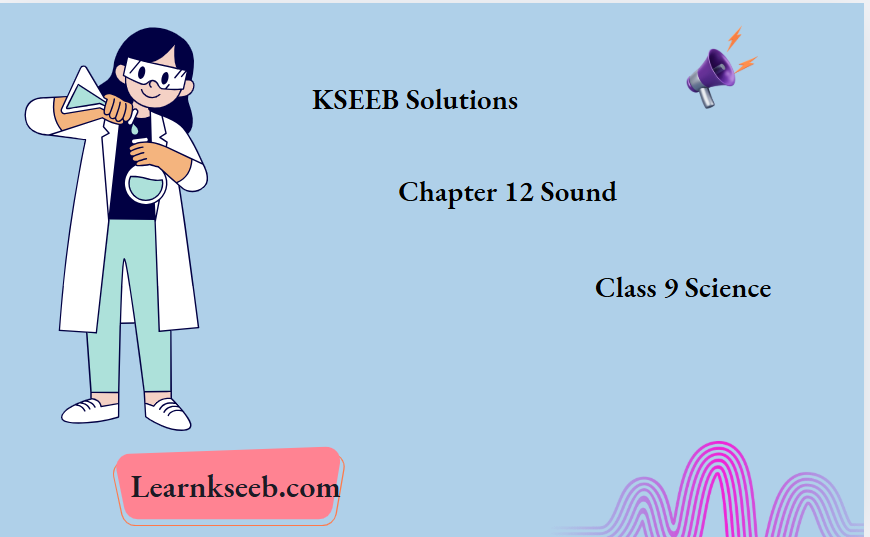
Sound Exercises
Question 1. How does the sound produce by a vibrating object in a medium reach your ear?
Answer: The vibrating object sets neighbouring air particles into periodic motion. This leads to the formation of compressions and rarefactions which through the medium and reach the tympanum of the ear. The tympanum membrane vibrates which leads to the sensation of hearing.
Question 2. Explain how sound is produced by your school bell.
Answer: When the bell is hit by a hammer, it begins to vibrate. The vibrations disturb the air particles which transfer the sound energy through he medium by periodic vibrations
Question 3. Why are sound waves called mechanical waves?
Answer: Since sound waves require a material medium for their propagation, they are called as mechanical waves
Karnataka Board Class 9 Science Chapter 12 Sound Solutions PDF
Question 4. Suppose you ad your friend are on the moon. Will you be able to hear any sound produced by your friend?
Answer: Since the moon is a barren place ie no atmosphere or a material medium, sound can’t travel in the moon. Hence friend cannot hear the sound
Question 5. What are the wavelength, frequency, time period ad amplitude of the sound wave?
Answer:
Wavelength(λ): For a transverse wave, the wavelength is the distance between two consecutive crests or troughs. For a longitudinal wave, it is the distance between two consecutive compressions or troughs. In general, it is the distance travelled by a wave in one period
Frequency(v): The number of vibrations executed by a particle of a medium or the number of waves produced by a source. It is measured in hertz (Hz)
Time — period (T): Time is taken by a particle to complete one vibration
Amplitude: Maximum displacement of a particle in vibration
Question 6. How are the wavelength and frequency of a sound wave related to its speed?
Answer: v = v λ where v = speed, v = frequency and λ = wavelength of sound waves
Question 7. Calculate the wavelength of a sound wave whose frequency is 220Hz and speed is 440m/s in a given medium.
Answer: λ= v/v = 440/220 2m
Question 8. A person is listening to a tone of 500Hz sitting at a distance of 450 m from the source of the sound. What is the time interval between successive compressions from the source?
Answer: Time interval between two successive compressions = 1/ f= 1/500 = m0.002sec.
Question 9. Which wave property determines
1) loudness
2) pitch
Answer: Intensity determines loudness and frequency determines the pitch
Question 10. Guess which sound has a higher pitch: guitar or car horn?
Answer: Guitar sound has a higher pitch than a car horn
Question 11. Distinguish between loudness and intensity of sound.
Answer:
Intensity:
1. It is the amount of sound energy incident per unit area per second
2. It is independent of the condition of the human ear
Loudness:
1. It is a physiological response of ear to the sound.
2. It depends on the intensity and condition of a human ear
KSEEB Class 9 Science Chapter 12 Sound Notes
Question 12. In which of the three media: air, water or iron does sound travel the fastest at a particular temperature?
Answer: Iron
Question 13. An echo returned in 3s. What is the distance sensation fo hearing? The sound produced by of the reflecting surface from the source, vibrations of objects given that the speed of sound is 342m/s?
Answer:
Speed of the sound = 342m/s
Total time take by the sound from the source to air near a source of a listener and the listener to source =3s
Total distance travelled = speed x time
= 342x 3 = 1026m
Distance of the reflecting surface from the source
= 1/2 x Half the total distance travelled
= 1026/2 = 513 m
Question 14. Why are the ceilings of concert halls of high curved?
Answer: It is done so to make sound after multiple object reflections reach all parts of the hall.
Question 15. What is the audible range of frequency of the average human ear?
Answer: 20Hz to 20kHz
Question 16. What is the range of frequencies associated with
1)Infrasonic sound and
2)ultrasonic sound?
Answer: For Infrasonic sound < 20Hz and for ultrasonic sound >20kHz
Question 17. A submarine emits a SONAR pulse, which returns from an obstacle underwater cliffin 1.02s. If the speed of sound in sla water is 1531m m/s, how far away is he cliff?
Answer: Total distance travelled by sound = velocity x time
2x ==. 153 x 1.02 m
x = 1531 x 1.02/2 = 780.81m
Thus distance of the cliffis 789.8m
Question 18. What is sound and how is it produced?
Answer: A sound is a form of energy which produces the sensation fo hearing. The sound produced by vibrations of objects
Question 19. Describe with the help of a diagram, how compressions rarefactions are produced in air near a source of the sound.
Answer:
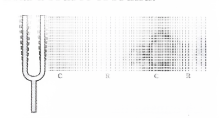
When a tuning fork vibrates, It pushes and compresses the air in front of it creating a region of high density and pressure called compression. This compression moves away from the vibrating object. When the vibrating prongs move backwards, it creates a region of lower density and low pressure called rarefaction as shown in the figure. As the prongs move back and forth rapidly, a series of compressions and rarefactions is created in the air. Thus the sound wave moves through the medium in the form of a series of compressions and rarefactions.
Question 20. Cite an experiment to show that sound needs a material medium for its propagation.
Answer: An electric bell is suspended inside an air-tight glass bell jar as shown in the figure. The bell jar is connected to a vacuum pump. When a switch is pressed, we will be able to hear the sound of the bell. Now the air from the jar is pumped out gradually. The sound of the bell becomes fainter. When the air is completely removed, we hear no sound from the jar. The experiment clearly indicates that sound requires a material medium for its propagation.
Question 21. Why is a sound wave called a longitudinal wave?
Answer: When the sound wave travels through a medium, the particles vibrate to and fro along the direction of the wave motion. Hence the sound is called a longitudinal wave
Class 9 Science Chapter 12 Sound Important Questions Karnataka Board
Question 22. Which characteristic of the sound helps you to identify your friend by his voice while sitting with others in a dark room?
Answer: Quality or timbre
Question 23. Flash and thunder are produced simultaneously. But thunder is heard a few seconds after the flash is seen, why?
Answer: It is because the speed of sound is much less than that of light
KSEEB Solutions For Sound Short Notes
Question 24. A person has a hearing range from 20 Hz to 20 kHz. What are the typical wavelengths of sound waves in air corresponding to these two frequencies? Take the speed of sound in air as 344m/s
Answer: Wavelength corresponding to 20 Hz = 344/20 = 17.2 m Wavelength corresponding to 20kHz = 344/ 20,000 = 0.0172m
Question 25. Two children are at opposite ends of an aluminium rod. One strikes the end of the rod with a stone. Find the ratio of times taken by the sound wave in air and in aluminium to reach the second child. Speed of sound in air = 346m/s and that in aluminium = 6420m/s)
Answer:
Time is taken by the sound in air=distance /velocity
= x /346 second
Time taken by the sound in Afuminium=x/6420
Ratio of times = (x/346) / (x/6420) = 6420/346 = 18.55
Question 26. The frequency of a source of sound is 100 Hz. How many times does it vibrate in a minute?
Answer:
Frequency = number of vibrations in 1 sec = 100
Hence the number of vibrations in 1 minute
ie 60 sec = 60 x 100 = 6000
Question 27. Does sound follow the same laws of reflection as light does? Explain.
Answer: Yes. Like light, the sound gets reflected from the surface of a solid or liquid and follows the same law of reflection. As in the case of light, the direction in which the is incident and reflected make equal angles with the normal to the reflecting surface and three lie in the same plane
Karnataka State Board 9th Science Sound Exercise Solutions
Question 28. When a sound is reflected from a distant object, an echo is produced. Let the distance between the reflecting surface and the source of sound production remains the same. Do you hear an echo sound on a hotter day?
Answer: No. This is because, during hotter days, the speed of sound decreases and the reflected sound returns to the listener in less than 0.1 s (The minimum time required to hear the reflection of sound)
Question 29. Give two practical applications of the reflection of sound waves.
Answer:
(1) Stethoscope is used to hear the sounds produced in the lungs and heart
(2) Megaphones which is used to send sound in a particular direction
Question 30. A stone is dropped from the top of a tower 500 m high into a pond of water at the base of the tower. When is the splash heard at the top? Given, g= 10 m/s2 and speed of sound = 340 m Is?
Answer:
Let s = 500m, g = 10m/s2, u = 0 and t = time taken by the stone to reach the base of the tower
Now we have s = ut + Vz gt2 => 500 = Vz (10) t2 => t2 = 100
Thus t = V100 = 10 sec
Time is taken by the sound to reach the top of the tower from the base = 500.340 = 1.47s
Thus splash of the sound is heard after 10 + 1.47
= 11. 47 sec
Question 31. A sound wave travels at a speed of 339 m/s. If its wavelength is 1.5 cm, what is the frequency of the wave? Will it be audible?
Answer:
Frequency = speed/ wavelength = 33 9/.015 = 22,600Hz (Ultrasonic sound) Hence the sound is not audible because the range of frequency of audible sound is 20Hz to 20,000Hz.
Question 32. What is reverberation? How can it be reduced?
Answer:
The persistence of sound in a large hall due to multiple reflections of sound is called reverberation. It can be reduced by
(1)By covering the roof and the wall of the auditorium by sound absorbing materials
(2)Using heavy curtains
Question 33. What is the loudness of sound? What factors does it depend on?
Answer: It is a physiological response of the ear to the intensity of the sound. It depends on
(1) Intensity of the sound
(2) Sensitivity of the human ear
Question 34. Explain how bats use ultrasound to catch prey.
Answer: During its flight, a bat emits ultrasonic waves. After receiving the reflected waves, the bat understands the nature of the object and its size before preying on it.
Question 35. How is ultrasound used for cleaning?
Answer: The objects to be cleaned are placed in a
cleaning solution and ultrasonic waves are sent into the solution. Due to high frequency, the particles of dust, grease and dirt get detached and drop out. Thus the objects are cleaned.
Question 36. Explain the working and application of a sonar.
Answer: Sonar is a device that uses ultrasonic waves to measure the distance, direction and speed of underwater objects. Sonar consists of a transmitter and a detector and is installed in a boat or a ship.
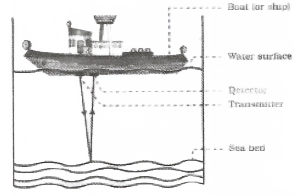
The transmitter produces and transmits ultrasonic waves. These waves travel through water and after striking the object on the seabed, get reflected back and are sensed by the detector. The detector converts the ultrasonic waves into electrical signals which are appropriately interpreted. The distance of the object that reflected the sound wave can be calculated by knowing the speed of sound in water and the time interval between transmission and reception of the ultrasound. Let the time interval between transmission and reception of ultrasound signal be t and the speed of sound through seawater be v. The total distance, 2d travelled by the ultrasound is then, 2d = v x t.
Question 37. A sonar device on a submarine sends out a signal and receives an echo 5 s later. Calculate the speed of sound in water if the distance of the object from the submarine is 3625 m.
Answer:
Given t = 5s and total distance travelled (2d)
3625 + 3625 = 7250m
Velocity of the sound in water = 2d /1 = 7250/5
= 1450m/s
Question 38. Explain how defects in a metal block can be detected using ultrasound.
Answer: Ultrasonic waves are allowed to pass through the metal block and detectors are used to detect the transmitted waves. If there is even a small defect, the ultrasound gets reflected back indicating the presence of the flaw or defect.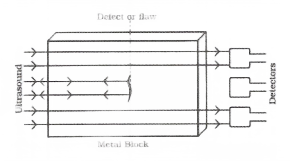
Question 39. Explain how the human ear works.
Answer: The outer ear is called ‘pinna’. It collects the sound from the surroundings. The collected sound passes through the auditory canal. At the end of the auditory canal, there is a thin membrane called the ear drum or tympanic membrane. When compression of the medium reaches the eardrum the pressure on the outside of the membrane increases and forces the eardrum inward. Similarly, the eardrum moves outward when a rarefaction reaches it. In this way the eardrum vibrates.
The vibrations are amplified several times by three bones (the hammer, anvil and stirrup) in the middle ear. The middle ear transmits the amplified pressure variations received from the sound wave to the inner ear. In the inner ear, the pressure variations are turned into electrical signals by the cochlea. These electrical signals are sent to the brain via the auditory nerve, and the brain interprets them as sound.
Sound Additional Questions
One Mark Questions
Question 1. What is the principle of a stethoscope?
Answer: Multiple reflections of sound
Question 2. Name two animals that can produce ultra¬sound.
Answer: Dolphins and bats
Question 3. What is the abbreviation of SONAR?
Answer: Sound navigation and ranging
Question 4. What is the nature of sound waves in the air?
Answer: Longitudinal nature.
Question 5. Can a motion be periodic but not oscillatory?
Answer: Yes. Uniform circular motion of an object
Question 6. What does that move in wave motion?
Answer: Energy
Two Marks Questions
Question 7. What is Sonic boom?
Answer: A very sharp and loud sound produced by the shock waves produced by a source of sound moving with a speed greater than sound is called a sonic boom.
KSEEB Solutions Chapter 12 Properties Of Sound Class 9
Question 8. What is a periodic motion? Give an example
Answer: The motion of an object which is repeated itself regularly in a fixed interval of time is called periodic motion.
Example: Motion of earth around the sun
Question 9. What is an oscillatory motion? Give an example
Answer: The to and fro motion of an object about a fixed position(mean position) is called an oscillatory motion. Example: Motion of bob of a pendulum
Question 10.Differentiate between mechanical waves and non-mechanical waves
Answer:
Mechanical waves:
1. Require a material medium for their propagation
2. Maybe longitudinal or transverse
3. Ex: Sound waves, Seismic waves
Non-Mechanical waves:
1. Do not require any material medium for propagation only transverse
Ex: Light waves, radio waves
Question 11.Mention the types of waves produced in the following cases
(1) When a stone is dropped into still pond water
(2) The weight attached to a spring is slightly pulled and released
(3) The string of Veena is plucked
Answer:
(1) Transverse waves
(2) longiudinal waves
(3) Transverse waves
Question 12. What is an echo? What should be the mini¬mum distance between the source of sound and the obstacle?
Answer: The phenomenon of repetition of sound due to reflection from a large rigid surface is called echo. The minimum distance between the source of sound and the obstacle must be 17.2m.
Question 13. Distinguish between echo and reverbera¬tion.
Answer: The repetition of sound due to reflection from an obstacle is called echo. The original sound and echo can be heard separately. Reverberation is the persistence of sound due to multiple re¬flections from many obstacles.
KSEEB Class 9 Science Sound Extra Questions with Answers
Question 14. What is ultrasonic or ultrasound? What are their special characteristics?
Answer: The sound whose frequencies are > 20,000 Hz are called ultrasound. They can travel along well-defined paths even through obstacles.
Question 15. How is ultrasound used to clean electronic equipment?
Answer: Objects are kept in a cleaning solution and ul¬trasonic waves are sent into the solution due to high frequency, the particles of dust, grease and dirt get detached and drop out.
Three Marks Questions
Question 16. What is echocardiography (ECG)?
Answer: The technique in which ultrasonic waves are reflected from various parts of the heart and an image of the heart is obtained on a screen is called echocardiography.
Question 17.Differentiate between Longitudinal and transverse waves
Answer:
Longitudinal waves:
1. The particles in the wave vibrate along the direction of the propagation of the wave motion.
2. The waves propagate in the form of alternate crests and troughs
3. Ex: Lightwaves
Transverse waves:
1. The particles vibrate in the direction perpendicular to the direction of the Wave motion.
2. The waves propagate in the form of compressions and rarefactions.
3. Ex: Sound waves
Question 18.Differentiate between Sound waves and light waves
Answer:
Soundwaves
1. Longitudinal in nature
2. Requires a material medium for propagation
Light waves
1. Longitudinal in nature
2. Does not require a material medium for propagation.
Question 19. Give a graphical representation of a transverse wave and longitudinal wave
Answer:
Transverse waves:

Longitudinal Waves:

Question 20. Ocean waves of time interval period 0.01s have a speed of 15m/s. What is the distance between a wave crest and the adjoining wave trough?
Answer:
Distance between a crest and the adjoining trough = 1/2 x wavelength
= 1/2 x velocity / frequency = 1/2 x 15/0.01
= 0. 075 m or 7.5cm
Sound Chapter 12 Class 9 KSEEB Textbook Solutions Free PDF
Question 21.Mention important medical applications of ultrasound sound
Answer: Electrocardiograph (ECG), Ultra scanning and breaking of small stones in the kidneys
Question 22. Draw a neat diagram to show the auditory parts of the human ear. Mention the functions of small bones present in the middle ear
Answer:
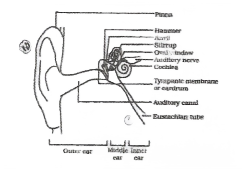
The small bones present in the middle ear amplify the vibrations several times
Four Marks Questions
Question 23. Explain briefly the propagation of sound in air.
Answer: When a source produces sound, it compresses air in front of it creating a region of high pressure. This region is called compression.
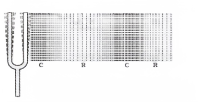
This compression starts to move away from the vibrating source. This leads a region of low pres¬sure called rarefaction as shown in fig. Due to elasticity and inertia, the compressions and rarefactions are transformed to neighbouring air particles. Thus a series of compressions and air particles help sound energy to propagate through air.
Question 24. Describe Bell jar experiment to show sound requires a material medium for its propagation (OR) Describe the Bell jar experiment to show that sound cannot travel in a vacuum.
Answer:
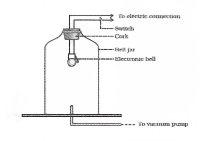
An electric bell is suspended inside an airtight glass bell jar as shown in the figure. The bell jar is connected to a vacuum pump. The electric bell is switched and the sound is heard clearly. Start the vacuum pump and remove the air in the jar gradually, the sound becomes fainter and fainter and finally stops when the air is completely removed. Even though the same current is flowing through the electric bell, we hear no sound. This experiment clearly demonstrates that sound waves cannot travel in a vacuum.
Question 25. What are called longitudinal waves? Mention their characteristics. Give an example.
Answer: The waves in which particles of the medium vibrate in the direction of wave motion are called longitudinal waves.
Characteristics:
1. They constitute alternate compression and rarefaction
2. They propagate through solids, gases and liquids.
3. They produce pressure changes in different parts of the medium
Examples:
1. sound waves
2. Waves inside the water
Question 26. What are called transverse waves? Mention their characteristics. Given examples.
Answer: The waves in which the particles of the medium vibrate in the direction perpendicular to the direction of propagation of the medium are called transverse waves.
Characteristics:
1. The wave contains alternate crests and troughs
2. They propagate through solids and on the surface of liquids
3. They involve changes in the shape of the medium
Examples:
1. light waves
2. waves in the stretched string
Question 27. What are called mechanical waves and non-mechanical waves? How are they produced? Given examples.
Answer:
Mechanical waves: The waves which require a material medium for their propagation are called Mechanical waves.
Mechanical waves are produced due to vibrations of particles of the medium
Example:
1. sound waves
2. water waves
Non – Mechanical waves: The waves which do not require any material medium or which can propagate through a vacuum are called non-mechanical waves.
Non – mechanical waves are produced due to electric and magnetic vibrations
Example:
1. light waves
2. Radio waves.
Question 28. Define the frequency and wavelength of a sound wave. Hence derive the relation V = +ve with the usual notation.
Answer:
Frequency: The number of oscillations completed by a particle of the medium in the wave motion.
Wavelength: It is the distance travelled by the wave in one period.
Relation V = +ve
The speed of sound is defined as the distance travelled by the wave in one second Speed (v) = distance/time
t / T
Here t is the distance (wavelength) travelled by the sound wave in one period (T) of the wave
Thus V = +ve
where v = frequency = \(\frac{1}{\text { period(T) }}\)
Question 29.
1) What is a hearing aid? How does it work?
2)Ordinary sound cannot be used to detect cracks and flaws in metal blocks why?
Answer:
1) Hearing aid is a battery-operated electronic device used by people with hearing loss
working of hearing aid:
A microphone in the aid receives sound and converts it to electrical signals. These signals are amplified by an amplifier. The amplified sound is fell into a speaker. The speaker converts electrical signals to the original sound and sends to the ear.
2) Ordinary sound waves have longer wavelengths and bend around the comers of the defective parts. Hence we cannot detect the flaws.
Sound Application Questions
Question 1. Megaphones or horn has a conical opening at the end. Why
Answer: It is designed to so to send most of the sound waves in the forward direction ie towards the audience.
Question 2. Why do some animals like dogs get disturbed before an earthquake?
Answer: Dogs can sense out the low-frequency infrasound before earth square.
Question 3. What happens to the speed of sound when the temperature is increased?
Answer: The speed of the sound increases.
Question 4. Name a phenomenon exhibited by the transverse wave but not a longitudinal wave
Answer: Polarisation
Question 5. Ultrasonic waves are used to detect cracks and flaws in metal blocks. Why.
Answer: Due to their short wave, they do not bend away from cracks.
Question 6. We can hear the sound of humming bees but cannot hear the oscillation of the pendulum.
Answer: The sound of humming bees has an audible frequency ( >20 Hz)whereas the oscillation of a pendulum has a frequency of < 30 Hz.
Class 9 Science Chapter 12 Sound Summary KSEEB
Question 7. Sound waves are longitudinal waves. Why
Answer:
In sound waves, the particles of the medium vibrate back and forth about their mean position. Light waves consist of an oscillating electric field and magnetic field and therefore do not require any material medium for their propagation.
Question 8. Why do we call light waves electromagnetic waves?
Answer: Light waves consists of an oscillating electric field and magnetic field and therefore do not require any material medium for their propagation.
Question 9. What type of waves are produced by prongs of a tuning force?
Answer: Longitudinal waves
Question 10. What do you mean by the acceleration due to gravity is 9.8ms’2?
Answer: It means the velocity of anybody falling freely a minute. Calculate its frequency under earth’s gravity changes by 9.8 m/s.
